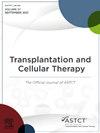Infectious Enterocolitis in Hematopoietic Cell Transplant with Post-Transplant Cyclophosphamide
IF 4.4
3区 医学
Q2 HEMATOLOGY
引用次数: 0
Abstract
Despite the high incidence of diarrhea in hematopoietic cell transplant (HCT) and the frequent involvement of infections, evidence concerning patients receiving post-transplant cyclophosphamide (PTCy) as graft-versus-host disease (GVHD) prophylaxis in the molecular diagnostic era is limited. This study aimed to evaluate the characteristics, incidence, risk factors, and outcomes impact of infectious enterocolitis in patients with hematologic malignancies undergoing HCT from matched sibling, matched unrelated, and haploidentical donors using PTCy as GVHD prophylaxis. Retrospective analysis of infectious enterocolitis episodes in 399 patients undergoing HCT at a single institution. Uniform GVHD prophylaxis with PTCy, sirolimus, and mycophenolate mofetil was given, irrespective of donor type or conditioning intensity. Levofloxacin was used prophylactically until myeloid engraftment. Infectious enterocolitis episodes were diagnosed by both molecular-based techniques and stool cultures. Infectious enterocolitis affected 21% of patients, with 19% having more than one episode. The median onset and duration was of 83 and 13 days, respectively, 20% were nosocomial and 58% were managed ambulatorily. The 1-year cumulative incidence was 19%, with 39% occurring beyond day 100, and was similar for Clostridioides difficile infection (CDI; 7%), non-CDI bacterial (8%), and viral enterocolitis (6%), with no differences in clinical features. However, toxin-positive CDI lasted longer (22 days) than toxin-negative cases (10 days, P = .03) Bone marrow HCT significantly increased the risk of overall infectious enterocolitis, while moderate-severe chronic GVHD increased all-cause and viral enterocolitis incidence. Infectious enterocolitis did not significantly impact overall survival, GVHD disease-free relapse-free survival, and non-relapse mortality. Approximately one-fifth of PTCy-based HCT recipients develop infectious enterocolitis in the first year, typically resolving within 2 weeks, with higher incidence in bone marrow recipients and those with moderate-severe chronic GVHD. CDI, non-CDI bacterial, and viral infections had similar incidences and clinical features. While infectious enterocolitis does not significantly impact transplant outcomes, its diagnosis remains challenging.
造血细胞移植后环磷酰胺治疗感染性小肠结肠炎。
背景:尽管在造血细胞移植(HCT)受者中腹泻的发生率很高,但移植后环磷酰胺(PTCy)用于移植物抗宿主病(GVHD)预防的感染性小肠结肠炎的数据仍然有限。目的:评估血液学恶性肿瘤患者感染性小肠结肠炎的特征、发病率、危险因素和对结果的影响,这些患者来自匹配的兄弟姐妹、匹配的非亲属和单倍体相同的供体,使用PTCy作为GVHD预防。研究设计:回顾性分析在同一医院接受HCT治疗的399例感染性小肠结肠炎患者。预防性使用左氧氟沙星直到骨髓植入。传染性小肠结肠炎发作是通过基于分子的技术和粪便培养诊断的。结果:感染性小肠结肠炎影响21%的患者,中位发病和持续时间分别为83天和13天,20%住院治疗,58%门诊治疗。一年累积发病率为19%,艰难梭菌感染(CDI;7%),非cdi细菌性(8%)和病毒性小肠结肠炎(6%),临床特征无差异。骨髓HCT显著增加了感染性小肠结肠炎的风险,而中重度慢性GVHD增加了全因性和病毒性小肠结肠炎的发生率。最后,感染性小肠结肠炎对总生存率、GVHD无病复发生存率和非复发死亡率没有显著影响。结论:我们的研究结果表明,大约五分之一的基于ptc的HCT接受者在第一年发生感染性小肠结肠炎,通常在两周内消退,但不影响HCT结果。骨髓受体和中重度慢性GVHD的发病率更高。背景:尽管在造血细胞移植(HCT)中腹泻的发生率很高,并且经常涉及感染,但在分子诊断时代,关于患者在移植后接受环磷酰胺(PTCy)作为移植物抗宿主病(GVHD)预防的证据有限。目的:本研究旨在评估血液学恶性肿瘤患者感染性小肠结肠炎的特征、发病率、危险因素和结果影响,这些患者来自匹配的兄弟姐妹、匹配的非亲属和单倍体相同的供体,使用PTCy作为GVHD预防。研究设计:回顾性分析在同一医院接受HCT治疗的399例感染性小肠结肠炎患者。无论供体类型或调节强度如何,均给予PTCy、西罗莫司和霉酚酸酯统一的GVHD预防。预防性使用左氧氟沙星直到骨髓植入。传染性小肠结肠炎发作是通过基于分子的技术和粪便培养诊断的。结果:21%的患者患有感染性小肠结肠炎,其中19%的患者不止一次发病。中位发病和持续时间分别为83天和13天,20%是住院治疗,58%是门诊治疗。1年累积发病率为19%,其中39%发生在100天以上,艰难梭菌感染(CDI;7%),非cdi细菌性(8%)和病毒性小肠结肠炎(6%),临床特征无差异。然而,毒素阳性CDI持续时间(22天)比毒素阴性病例(10天,p=0.03)。骨髓HCT显著增加了感染性小肠结肠炎的风险,而中重度慢性GVHD增加了全因性和病毒性小肠结肠炎的发生率。感染性小肠结肠炎对总生存率、GVHD无病无复发生存率和非复发死亡率没有显著影响。结论:大约五分之一的ptc受体在第一年发生感染性小肠结肠炎,通常在两周内消退,骨髓受体和中重度慢性GVHD患者的发病率更高。CDI、非CDI细菌和病毒感染的发生率和临床特征相似。虽然感染性小肠结肠炎对移植结果没有显著影响,但其诊断仍然具有挑战性。
本文章由计算机程序翻译,如有差异,请以英文原文为准。
求助全文
约1分钟内获得全文
求助全文
来源期刊

Transplantation and Cellular Therapy
Medicine-Hematology
CiteScore
7.00
自引率
15.60%
发文量
1061
审稿时长
51 days
 求助内容:
求助内容: 应助结果提醒方式:
应助结果提醒方式:


